Please fill out the form below to compare replacement window companies in your town. It makes no difference if you are looking for vinyl replacement windows or other window replacement companies.
Thanks,
![]()
Please fill out the form below to compare replacement window companies in your town. It makes no difference if you are looking for vinyl replacement windows or other window replacement companies.
Thanks,
![]()
| "Tim, I've worked with The New York Times, The Detroit News, The Detroit Free Press, The Flint Journal, Discovery Channel Kids, Discovery Channel Yearly Science Book, Giza Pyramid Research Association plus several others and never had this kind of response. Tim the Builder Guy is popular. Your people listen to you!"
- Wally Wallingford - The Forgotten Technology
|
|
| Do you want results like Wally got? Then read this:
The nearly one million unique visitors per month, and the 100,000 devout subscribers to my weekly newsletter want to know about your new products! That's a fact. I know, because I surveyed them! Here are just a few of the Advertising Opportunities at AsktheBuilder.com:
Download my full Media Kit now. What's your Dream Ad Campaign? I'll bet I can satisfy your desires. Contact me now.
|
 Click to view a copy of the AsktheBuilder.com Media Kit. Click to view a copy of the AsktheBuilder.com Media Kit. |
| Text Link Policy: We get repeated requests from websites that want to purchase a text link from AsktheBuilder.com. The web sites, that want the link, are trying to boost their position in the search engines. It's a very selfish act when you think about it. The better way to increase your ranking is by doing it slowly and organically, the way AsktheBuilder.com has done it since 1995. The best analogy I can offer is the feeling you get while watching someone cut into a line in front of you so they don't have to wait. That's selfish behavior, and Google doesn't like selfish websites, nor do they like the websites that assist the line cutters. We don't want to be frowned upon or shunned by Google, so we don't sell text links. It's that simple. |
|
Using the wrong tools or cleaner will make your job harder. Using newspaper is not a good alternative. The water in the cleaner will dissolve the newsprint ink and leave that residue on the window. All you need to professional results is the right cleaner solution, lambs wool cleaner (or scrubber) and a squeegee. The squeegee is used to remove the excess moisture from the window. The window will be clean before the squeegee is used.
Mix the cleaner solution and dip the lambs wool cleaner into the solution. Wipe off the excess solution and start cleaning the window. Go over the window up and down and back and forth. All the dirt will be trapped in the lambs wool. Then use the squeegee to remove the excess moisture off the glass. Wipe the squeegee blade after each pass on the window.
These tools are available at your local paint store. There is also a two in one tool with the scrubber and squeegee on one head. This has a spot to attach it to a long pole for cleaning those second story windows.
This relaxation period will be about 5 minutes. Then the wall covering will be ready to hang.
Full pieces of drywall weigh a lot. How can the small drywall screws hold all that weight to the ceiling or walls? On the nail shank, there are little grooves. These nails are called ring shank nails. These make the nail act like a screw and hold tight in the wood. The grooves act as barbs to hold the drywall. The underside of the screw is flared so when you drive it into the drywall, it will not tear the paper coating.
Drywall screws have a bugle head. This conical shape provide a lot of surface area for the screw to hold the drywall in position. Don't drive the screws in too far or you will tear the paper. If that happens, the screws lose their holding power.
There is a special drywall hammer for driving in the nails. The head of a regular hammer has square edges. This can tear the paper. Not good! The drywall hammer has a larger diameter head with rounded edges and cross-hatching on the face. This provides an indent on the drywall around the nail so that the drywall mud holds better.
It pays to have the right tools and fasteners when hanging drywall.
When taking your standard metal toolboxes to the jobsite, try one of the new tool backpacks. A tool backpack is great for carrying tools up a ladder or when you have to carry other objects at the same time. These backpacks have lots of pockets to organize your tools. You can store screwdrivers, razor knives, pencils, drywall hole cutters, tape measures, etc. in individual pockets.
Inside the larger section of the backpack, you can store your wrenches, pliers, hammers in place with elastic bands. The center area can handle that cordless drill.
On the outside, there are special pockets to hold your cell phone, a water bottle or any other smaller items.
These backpacks are a great way to carry your tools and keep your hands free.
In case you break something and have to repair it, there are wood glues to handle your repair project. The most common is the yellow carpenter's glue. This kind of glue works well for gluing two pieces of wood together.
An outdoor wood glue is available for those projects were the repair will be exposed to water.
The urethane glues are very sticky and are like epoxy glues. They will glue most things together. There is a chemical reaction, called curing, when the glue dries. Water is required to make this glue work. Sponge a little water on the wood, apply the glue and clamp the two pieces together. This is important because the glue will expand as it dries. If you don't clamp it, the pieces can move during curing. Once dry, the urethane wood glue can be sanded, painted or stained. Just be sure to clamp the pieces together!
I had the extreme good fortune to visit New Orleans the first week of January 2007. The Hurricane Katrina disaster happened 16 months before, and the disaster recovery efforts I witnessed were minimal. My takeaway from visiting the area was that on a personal level my family is not adequately prepared for a major disaster. I'm willing to wager that most people are not prepared to deal with a large-scale natural disaster that could result in utilities or services being disrupted for days or weeks.
Disaster preparedness, I believe, is a two-phase process. Resign yourself now to the fact that you will have to deal with both short term and long term disaster management. You are going to have to react immediately to take care of yourself right after the disaster, and then it may take months or longer before your life and home are back to normal.
For example, let's imagine your area is hit with a major wind or ice storm that knocks out electric power to hundreds of thousands of customers. (The disaster could be any event such as an earthquake, hurricane, major snowstorm - some event that affects many people and brings an area to its knees.)

This is storm debris from Hurricanne Katrina 16 months AFTER the monster raped the suburb of Lakeview in New Orleans. The debris has been at the curb for who knows how long. The house being rebuilt is not the norm. Many more houses sat empty, forlorn and vacant than were being rebuilt. PHOTO CREDIT: Tim Carter
Let's also assume that the damage occurs at many individual houses so the utility company workers are vexed with the problem of reconnecting tens of thousands of customers. How many trucks equipped with cherry-picker buckets do you think your local utility company operates? Fifty, 75, even 200? Even if your utility company has a mutual-aid agreement with utility companies located in other states and cities, how many crews will come to your city or town, and when will they get there?
How many hours a day do you expect the utility crews that man each truck will work? It is unreasonable for you to expect them to work 24 hours a day non-stop until all houses are reconnected. Fatigue can cause mistakes - deadly ones.
Furthermore, keep in mind the utility companies have a list of priority customers that serve the public good that must be connected long before you need power. Hospitals, government offices, communication centers, critical businesses, food distributors, gas stations, etc. are at the top of this list. It could be weeks before your home gets electric power, water, natural gas, etc. restored.
The initial response to disaster recovery should be on a personal level. Even though you and I pay taxes, do not expect the government at any level (Federal, State or Local) to be at your beckoned call. For one, they simply do not have the manpower nor equipment to help all people at once in a large-scale disaster.
Plan to help yourself and your family. Period, end of story. If you do get help at some later date, fine; but operate as if there is no government. In my opinion, those who feel the government should take care of them and bail them out of trouble are living in a dream world.
This means that you will need to have enough food, water and other supplies for days and possibly a week, maybe even longer. Think about everything you, your family and your pets consume - water, food, medication, etc. All must be on hand in sufficient quantities so you can survive for five, seven, perhaps ten days. It may be smart to have up to a month's supplies on hand. Crazy as it sounds, it might be prudent to install an above-ground swimming pool that has thousands of gallons of water available for all sorts of uses, including basic fire protection.
You don't have to eat steak each day, so think about foods that are canned and can survive with no refrigeration. Meals Ready to Eat (MREs) that are issued to our military personnel are affordable and delicious. I have eaten these, and not only are they tasty but they also offer a great variety of nutritious food in the sealed package. They come with special heat packs that mix with water to make the food hot.
Most of us have become far too reliant upon electricity, so think about investing in a portable generator. Many common gasoline-powered generators are not large enough to supply you with all of the electric you typically consume at one time. You can purchase a giant generator to supply you with all of the electricity you need, but there is a good chance the price will take your breath away.
If you do purchase a smaller portable generator that generates 5,000 watts or less, you may have to do some rewiring so that only critical appliances and lighting circuits are powered by the generator. Plan to have rolling blackouts in your own home as you run certain things for a period of time, then switch the generator to other circuits, appliances or lights.
If you do not know how to properly connect a generator to your household electric system, hire a licensed electrician to do it for you. It is vital they are connected to your electric system properly so you do not injure a utility company worker by feeding power backwards into the grid. This connection is typically done with a transfer switch.
Think about stockpiling supplies to temporarily secure your home in the event of roofing damage, broken windows, flooding, etc. These supplies could disappear from stores in hours after a storm. This assumes the stores are even open and have power to sell them. Buy large fiberglass tarps that will create a temporary roof. Invest in sheets of plywood that will cover broken windows or doors. Have all the supplies you need to clean up after flooding or any water intrusion. Make sure you have all needed fasteners, ropes, screws nails, hand tools, etc., to secure the tarps, plywood or whatever covering you intend to use.
Flashlights and any other type of portable lighting will become invaluable. Have plenty of fresh batteries on hand. I am not talking one or two packs. You may need 20, 30 or even 50 batteries to keep your portable devices powered up for days or even weeks.
Purchase flashlights that are hand powered. I own a flashlight that you wind up and it works for hours before needing additional cranks. You can buy radios that operate with a hand crank and even have solar panels for daytime operation on sunny or partly cloudy days.
Think long and hard about communications. Your traditional phone may not work after a storm. Cell phone batteries will die after a day or so. My amateur radio license ( W3ATB) is invaluable as I can communicate with a small handheld radio that can broadcast and receive up to 25 miles. No cell phone has a reach like that. It takes a little work to get an amateur radio license, but the day may come when it could save your life and get you help when others around you are waving blankets, spray painting messages on roofs or are trying to send smoke signals.
Now is the time to go over your insurance coverage, not after the disaster. Read your policy closely to see exactly what is and is not covered. Pay very close attention to the wording about water damage. Determine if you are covered if water rushes into your home overland or seeps in through walls and up from floors.
You might be shocked to discover you have no coverage for many instances when water enters your home. You will have to purchase a separate policy to cover you for flood damage. These policies are part of a Federal Government program. Sewer backups and other forms of water infiltration may be covered by a rider to your existing homeowner's policy.
The bottom line is you need to really understand what constitutes a valid insurance claim. It goes without saying that you need to be sure you are fully insured. Your current policy may not have upper limits that cover the lion's share of your total damage claim.
Upgrade your policy if your coverage is weak or non-existent in certain areas. Keep in mind that the insurance company is just going to write you a check, not arrange to have the repair work done. You need to think now who you might call in the event of a problem. After the disaster strikes, contractors, especially the good ones, will already be busy. They will undoubtedly service past customers, not new ones they do not know.
It could be months, many months before repair work is done on your home. Now is the time to bone up on temporary repairs you may have to do yourself to secure your home until such time as a good contractor can be found who will do permanent repairs. Think and act like a seasoned Boy/Girl Scout - Be Prepared!
And for all you ham radio operators: I'm clear on your final.
Column EM0048
The following Hurricane Katrina photos were taken on January 3, 2007. The house photos were taken in the suburb of New Orleans called Lakeview. The beach photos were taken in Waveland, MS. All photos were taken by me.
I could have taken hundreds more photos, and now wish I had. Perhaps the best thing would have been a video that also had the soundtrack. The point being there was the absence of sound at all locations where we were. There were few people around, no cars, no traffic, nothing that would create the ordinary sounds you might hear in a living, breathing neighborhood.
If you want to read the story about why Kelly and I went to visit New Orleans and see firsthand the destruction caused by Hurricane Katrina, CLICK HERE.

This is a very typical abandoned house. You can see the search-team code inside the screened porch. Debris was everywhere, on roads, lawns, sidewalks, etc. It is my guess the debris has been laying there since the flood water receded. |
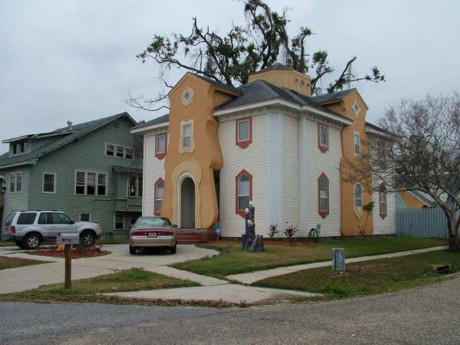
This unique home is new or a complete restoration. This was a very rare thing to see. I loved the spirit that the house seems to be screaming. The owners are back and proud to be there. That much is very obvious. |
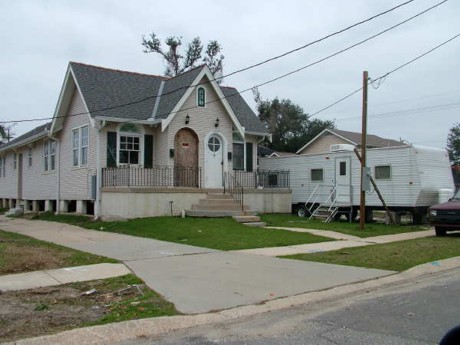
This cute home is also a restoration. The trailer provided shelter for the past 16 months. |
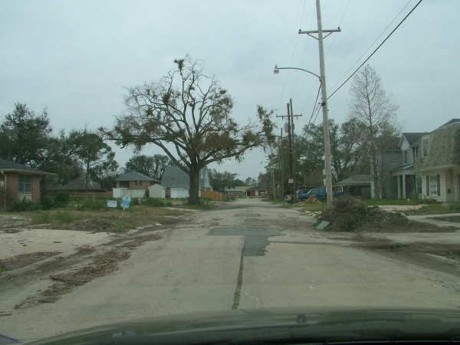
This is a typical street. Houses for sale, debris at the curb, debris in the street and an occasional car or truck parked in a driveway. We didn't see one person walking, jogging or outdoors at all. |
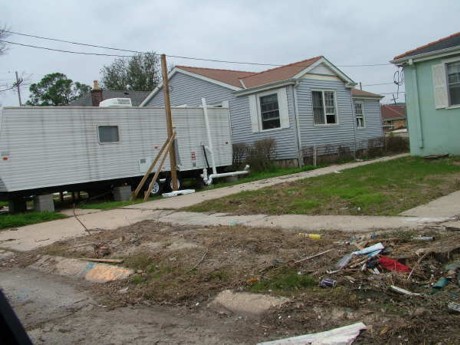
Another temporary trailer, debris, weeds,and roadway in disrepair. |
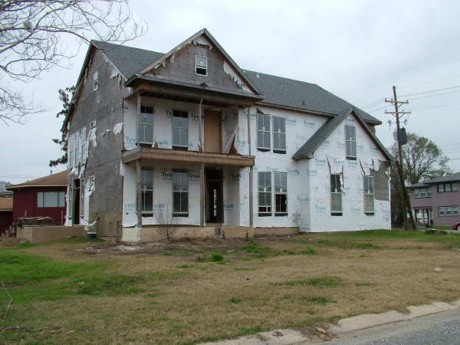
I think this house was under construction before Hurricane Katrina. The storm ravaged the Tyvek house wrap. Plus, the OSB sheathing is very gray indicating to me it has been exposed to sunlight for quite some time. |
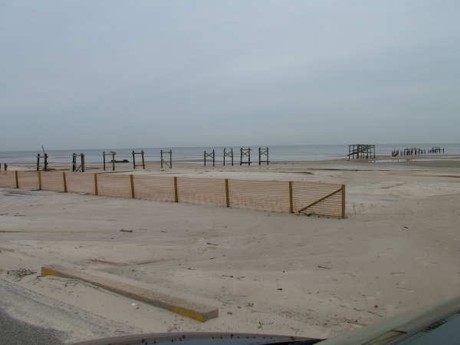
The deserted beach in Waveland, MS. This is all that is left of some fishing pier that extended out into the Gulf of Mexico. |
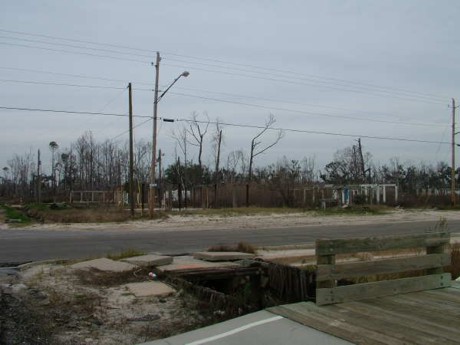
The piers on the other side of the road used to have houses on them. Can you imagine being under 20 feet of raging water right here? The wave action as the storm surge got higher and higher pulverized the houses. As the water receded, it took much of the debris back out into the gulf. It is VERY unsafe to swim in the water at the beach, because of all of the debris just under the sand. |
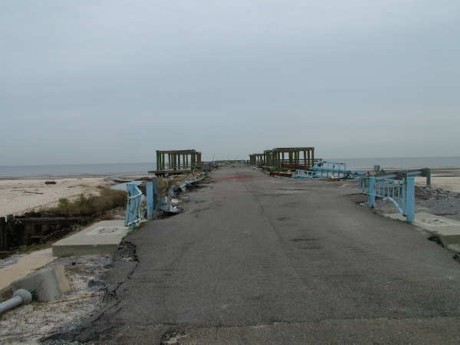
As best as I can determine, this is all that is left of some commercial pier. There may have been fishing bait shacks, gift shops, food stands, etc. on this pier. Perhaps some Waveland, MS resident will help me out and tell us what was once here. The blue gates are an obvious clue. There was a parking lot between the beach and the Beach Boulevard immediately to the right of this photo. That told me that a public swimming beach must have been on either side of this pier. |
Matthew Mims of Kenner, LA wrote to me within hours of this page being published. He said:
"My grandmother had a house on the first block of Terrace Drive which is just across the street from the pier.
I believe the pier was named the Gardfield Ladner Memorial Pier. It was a very long fishing pier that was built around 1987, and added on to about ten years ago. There were a few pavilions at the pier, and there was talk about turning that area into a marina prior to Hurricane Katrina.
The worst part about Waveland is that the place does not look a whole lot different today than it did a year ago when we made our first trip down there post-Katrina."
Author's Note: More photos of Katrina-damaged houses in New Orleans here.
On New Year's Day 2007, my youngest daughter Kelly and I packed ourselves and some luggage into our car and headed off to New Orleans, LA . We had tickets to attend the Sugar Bowl game. We left a day early so we could tour New Orleans and the surrounding countryside to see Hurricane Katrina damage. It never crossed my mind that my 14-year-old daughter would utter one simple sentence in a moment of frustration that would forever change how I look at my own home and all the people, pets, and things that are inside it.
Sixteen months had passed since the monster storm had plundered New Orleans and points east, so surely cleanup and rebuilding efforts had healed the scars from Hurricane Katrina. Well, you know what happens when you assume something. On the second day of our drive, we followed Interstate Routes 59 and 10 from the north towards the Big Easy. Just after crossing the border between Mississippi and Louisiana, signs of Katrina were everywhere.
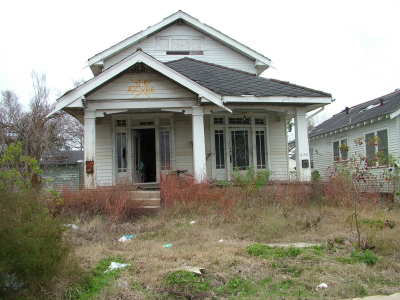
This is one of thousands of vacant homes in the city of New Orleans. Rebuilding is happening in some neighborhoods, but houses like these far outnumber those being rebuilt. PHOTO CREDIT: Tim Carter
Still many miles from the French Quarter, twisted and snapped trees, empty storefronts, piles of debris and drapes fluttering out of open windows was the "Welcome to New Orleans" sign that whispered to Kelly and I we had arrived on a desecrated part of the Gulf Coast. How, after these many months, could all of this damage still be visible? Why wasn't it being cleaned up? Where were all of the workers trying to breathe life back into the outer edges of this historic city? The answers would come the next day.
"You want to see a hard-hit area, go to Lakeview. It's off Interstate 10 just before the airport. Drive down any street," said Bill Kingman, a friend of mine who acted as our guide on the first day of our arrival. Bill, a resident of New Orleans for the past 22 years, was in Iraq when Katrina hit, and his home missed being flooded by just inches. But he had many friends and neighbors who had lost everything. Bill told us all sorts of tales about the storm as we walked through the seemingly untouched French Quarter.
Dawn broke with a steely gray on our second day in New Orleans. Since the Sugar Bowl game kickoff was not until 7:30 p.m., Kelly and I had the better part of a day to tour the city, and do some shopping. "Let's go take some Hurricane Katrina pictures, " I said after eating breakfast. Kelly sighed, shrugged her shoulders and murmured, "Okay." No doubt I am pretty out of touch with the top ten things a 14-year-old girl wants to do while visiting New Orleans.
The suburb of Lakeview was less than a ten-minute drive from our hotel on the edge of the French Quarter. Getting off the expressway ramp, I immediately sensed something was wrong. There was some traffic on the Clearview Parkway, but the streets that branched off this main thoroughfare were deserted.
For Sale signs stood guard over house after house that had windows missing, doors open and the spray-painted tattoos left by the search teams looking for survivors or those less fortunate. Each damaged house also bore the indelible black ring marking the high-water line as well as secondary rings recording the slow recession of the murky brew as it was pumped back to the sea.
After taking several Hurricane Katrina photos of this aftermath, I was pulled by the invisible force of curiosity to where the wicked beast had made landfall. I needed to see exactly where the center of the vortex smashed into the coast. Kelly and I pointed the car to the east and set our sights on Waveland, MS.
An hour or so later we entered the town limits of Waveland, MS, a small hamlet on US Route 90. There was a small sign that pointed to the Waveland Beach. Perfect. That's exactly where I wanted to go. Kelly and I turned down the small road and couldn't see the beach at all. No wonder, we were well over a mile or more away.
But as Kelly and I crept south towards the water's edge, we did see concrete slabs at the end of deserted driveways on either side of this small road. Fifty and sixty-foot-tall pine trees with trunks as large as 55-gallon drums were snapped in two like dried twigs. The remaining trunks were poking up out of the sand about 15 or 20 feet. Katrina's fierce storm surge had reached that high, and the howling wind and crashing waves must have snapped off the tops of the trees above the water line.
The damage and destruction kept getting worse as we got closer to the beach. Mother Nature had decided to wipe away all traces of habitation of the land. She decided she wanted the Waveland area to be like it was 400 years ago. She almost achieved perfection.

This is the deserted beach at Waveland, MS.
When we arrived at the end of the road at the beach, there was a large sign warning people to not go into the water. The sign mentioned sharp metal fragments, broken glass, etc. that would slice your feet and legs like a brand-new razor. Trust me, I had no inclination to wade in the Gulf of Mexico.
There was an eerie silence wrapped around us. All you could hear was the gentle lapping of the salt water as it tried to cleanse the beach area of all the debris. That, no doubt, would take many decades without help from us.

This is all that's left of the Gardfield Ladner Memorial Pier in Waveland, MS.
I stood in awe of the enormous power of Katrina.
Kelly finally spoke up, "Dad, I don't get it. There's nothing here. Why in the world did you want to drive an hour to see nothing?"
The first thought that crossed my mind was, "That's exactly why I wanted to come here. To see how a hurricane takes something and churns it into NOTHING.
I said that to Kelly and took a few more photos.
We got back in the car and drove in silence all the way back to New Orleans.
If you live in the path of a hurricane that's going to produce a record storm surge like Katrina, you need to evacuate. Hurricanes are just like the Game of Thrones.
When you play the Game of Hurricane, you win or you die. There is no middle ground.
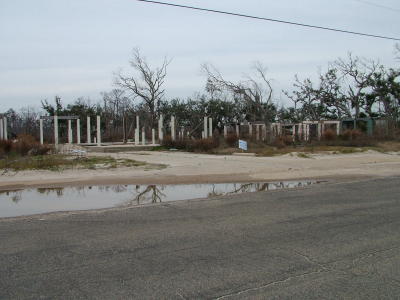
This was some building just back from the beach in Waveland, MS. All that's left are concrete piers and the building slab. Copyright 2007 Tim Carter All Rights Reserved
Subscribe to the FREE Ask the Builder newsletter to receive professional advice for your home. Complete the form below and each week you'll get:
Unsubscribe at any time. We respect your email privacy.